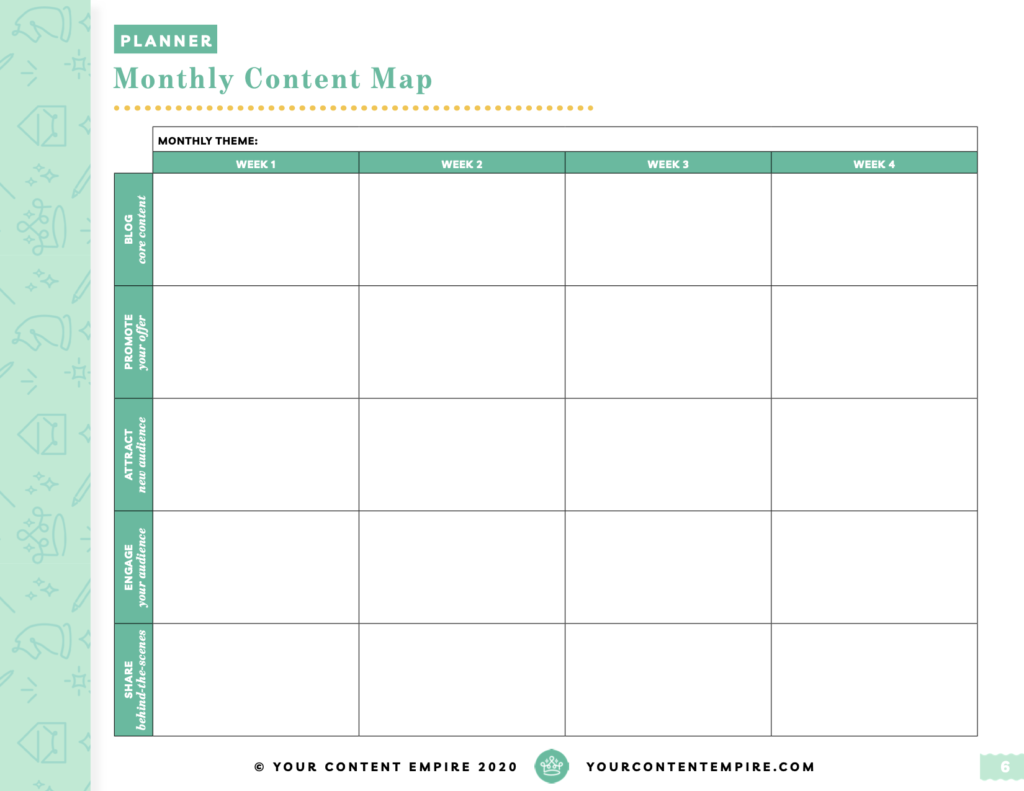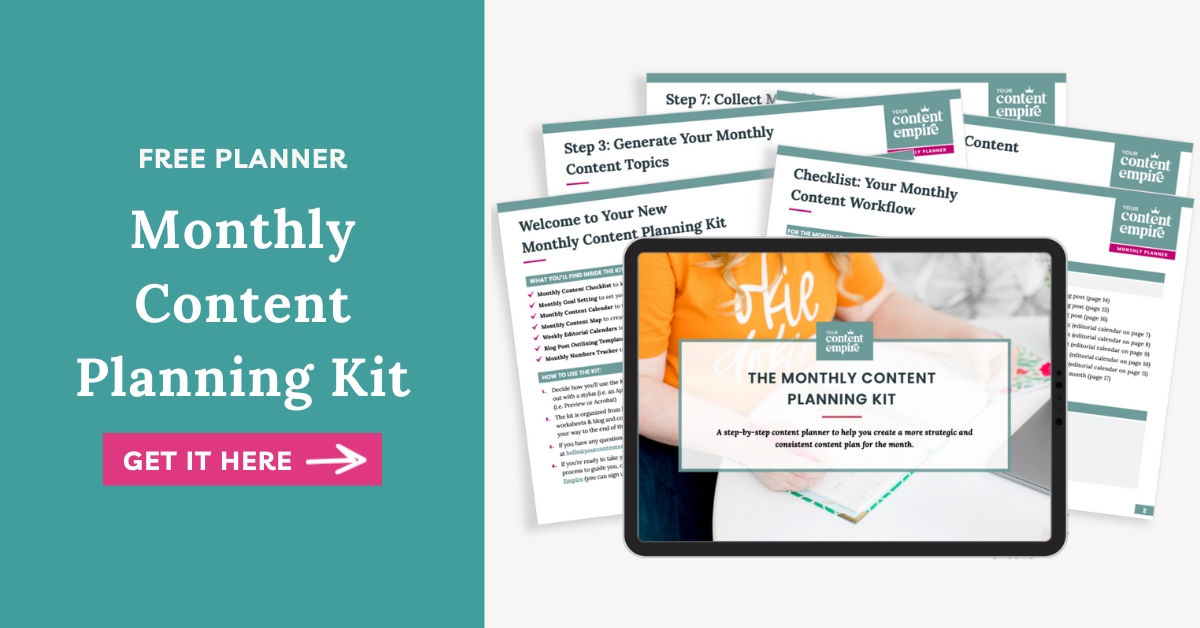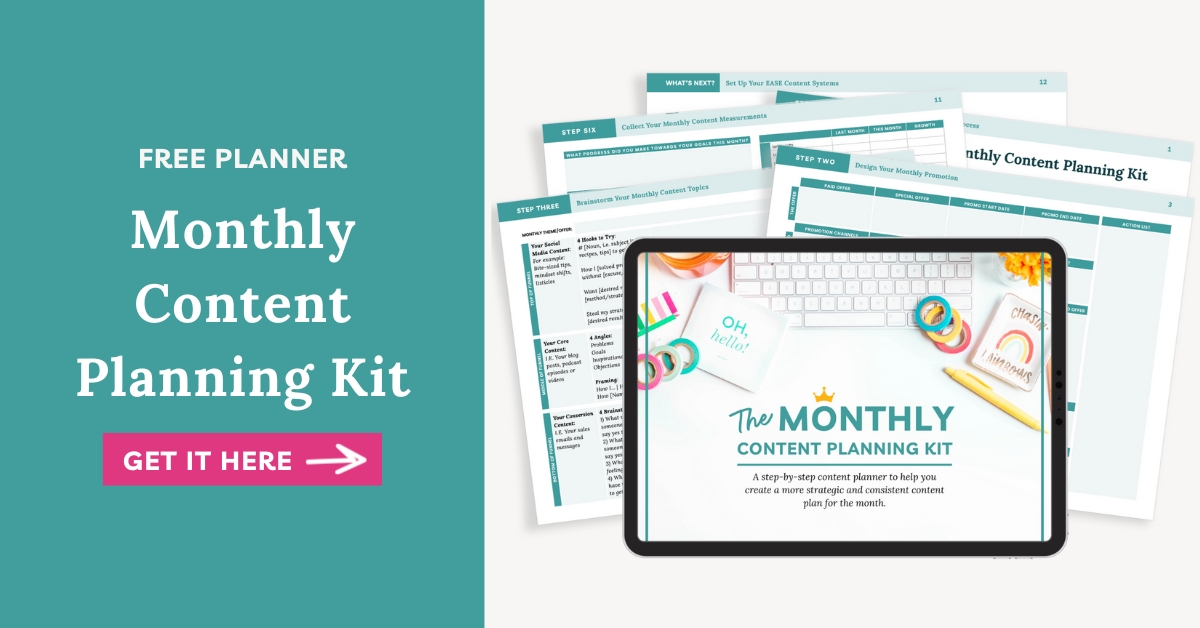Last year, I had an entire membership dedicated to this monthly content planning process (as well as for executing it). And while I discovered that I really dislike having a membership because #introvertproblems, I did love the front-row seat to see how this process helped so many people put out a lot of great content really consistently.
Monthly content planning is the Goldilocks of the content strategy world.
It’s not too far in advance that you forget why you thought writing a blog post about the inner workings of baking bread [insert your own niche here] was a good idea.
And it’s not too near in the future that you don’t have a snowball’s chance in hell of getting it done in time.
It’s just right.
Plus a lot can change in even just a month so by planning your content monthly, you’ll help keep your content fresh and relevant to what’s actually going on in your business.
So this post is going to walk you through my 6-step process for planning your content monthly…
Plan Along With Me
Want to plan along with me? This whole process utilizes my free Monthly Content Planning Kit so you can download it and transform this blog into your own personal coworking session:
Step 1 – Reflect on Your Past Month
Before we go forward, we’ve gotta go back to look at the past month (or the most recently completed month).
Your present business, marketing and sales results are a product of what you were doing within the last 3 months or more and so the past holds so much valuable insight that you can use to intentionally craft your way into the results you want.
But we have to gather that data first…
It starts with a quantitative review:
- Website analytics: Total traffic, unique traffic, bounce rate, average website visits
- Email analytics: Total subscribers, new subscribers, # emails sent, average email opens and clicks
- Funnel analytics: Total people who signed up for your funnel, total purchases or consult calls booked (depending on goal/purpose of your funnel), conversion rate of the funnel, open and click rates of the emails
- Social analytics: Followers and traffic generated from each
Then move onto a qualitative review (because numbers are important but they’re not everything):
- Biggest wins from the past month
- What worked this month
- What didn’t work this month
- Where did new clients and customers come from this month?
Step 2 – Choose a Promotional Focus for the Month
Never forget that you’re a business owner (even if you’re just starting out) who’s using to reach businessy type targets – like building up an interest list, increasing sales, establishing your expertise. Not creating content for the sake of it.
So choose 1 thing that you want to focus on promoting for the coming month with your content. Ideally, this is a paid offer but it can also be a free one too if your goal is to list-build.
Step 3 – Fill Out Your Monthly Calendar
Get a blank monthly calendar (in my Monthly Content Planning Kit, this is called the Business Activity Forecast) and add in any business events or activities that are occurring this month. These could be campaigns or collaborations that you’re running, events you’re going to or anything else that is happening business-wise.
I also recommend adding in any personal events that are going to impact business operations. You may need to plan for content coverage during these periods.
Step 4 – Topic Brainstorm
I have a number of different topic brainstorming methods that I pull out because switching it up breeds more creativity but the following is a staple and it’s a big part of the Monthly Content Planning Kit.
Here’s what to do for the mind-mapping topic-storming technique:
- Put your promotional focus at the centre of your mind map
- Then in the next layer of boxes – come up with 3-4 different angles to approach your offer from
- Then for each of those angles – what are specific questions you can answer or topics you can cover?
- Once you’re finished mind-mapping, it should be apparent which direction to go based on which questions you’re the most excited about answering. Try to stick with questions all from one angle however for cohesiveness. You can save the other ideas for later
Here’s an example:
So if I were selling my signature program, the $10K Monthly Content System or the Profitable Funnel Sprint, I’d put it at the center. Then for the potential angles I can take for selling it, I’d put sales funnels, content campaigns, content systems and traffic generation. Then I’d brainstorm specific questions within each of those ‘angles’ like ‘how do you plan a funnel to sell an evergreen course’ or ‘how do you fix a broken funnel.’
Step 5 – Complete Your Monthly Content Map
This is my favourite tool in the entire Monthly Content Planning Kit because it gives you a map to follow for your content. Even if you don’t do any other sheets in the kit, I consider this one essential.

Here’s how to use it:
- Start by putting your monthly promotional focus at the top
- Then put the blog post topic you plan on releasing each week (and FYI – blog refers to videos and podcast episodes as much as it does to written blog posts)
- Then for each week, plan what you’re going to do to promote (aka sell) your promotional focus. This might emails, personal outreach, retargeting ads, etc.
- Next, for each week put what you plan on doing to attract new people to your audience. This might be a traffic-focused strategy like Pinterest, collaborating or pitching podcast interviews
- Then for each week, plan how you’re going to engage with your existing community. Maybe you have a Facebook group or are all up on your Instagram connecting with your people
- And a wild card here – any other content you’ll be releasing this week of the month. Usually, I’ll put a behind-the-scenes reminder of something that’s going on in my business that I want to make a point of sharing
Step 6 – Create Your Weekly Editorial Calendars
This is where we get down to the nitty-gritty of planning your content – your weekly execution plans. Start by putting all of the channels that you’re present on and then what is going out on each of these channels daily throughout the week.
You’re definitely not trying to filling every single bucket/square here. Like with the blogging column, I wouldn’t typically recommend blogging every single day – especially for a business using content versus a blogger.
These weekly editorial calendars can now become both your checklist for creating your content and publishing it.
Challenge: Plan Along With Me
So my challenge to you is to create your next monthly content plan. Download the FREE Monthly Content Planning Kit and watch the video to plan along with me.








